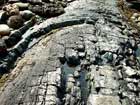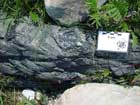GEOLOGICAL
HIGHLIGHTS - JUDD'S DYKES
 Along
the western shore of Arran, between Tormore and Blackwaterfoot, a series
of dykes and sills can be seen. Known collectively as Judd’s Dykes,
after the geologist who first studied them in the late 1800’s, these
rocks are a classic example of composite intrusions. Along
the western shore of Arran, between Tormore and Blackwaterfoot, a series
of dykes and sills can be seen. Known collectively as Judd’s Dykes,
after the geologist who first studied them in the late 1800’s, these
rocks are a classic example of composite intrusions.
  The
variable compositional nature of these dykes and sills reflect the simultaneous
availability of basic and acidic magmas. The original magma would have
been a differentiate of mantle melt, which later became altered by contamination
from crustal material. Magmatic fractionation processes could have produced
the acidic and basic magmas which may have existed in a stratified magma
chamber. The
variable compositional nature of these dykes and sills reflect the simultaneous
availability of basic and acidic magmas. The original magma would have
been a differentiate of mantle melt, which later became altered by contamination
from crustal material. Magmatic fractionation processes could have produced
the acidic and basic magmas which may have existed in a stratified magma
chamber.
  This
reservoir would have been tapped on various occasions to release the different
types of magma. Often, the magma would exploit the zones of weakness provided
by previous intrusions. This process juxtaposes intrusions of strikingly
different composition, hence the name composite intrusion. This
reservoir would have been tapped on various occasions to release the different
types of magma. Often, the magma would exploit the zones of weakness provided
by previous intrusions. This process juxtaposes intrusions of strikingly
different composition, hence the name composite intrusion.
|

